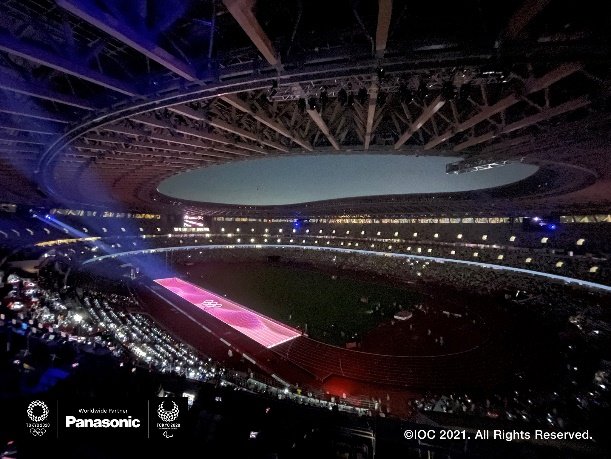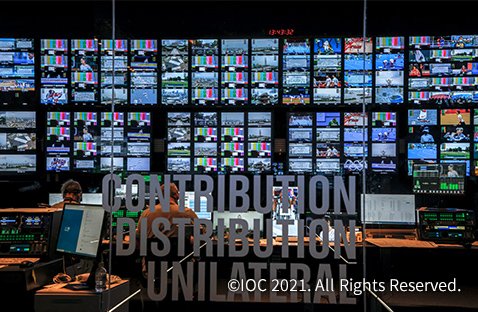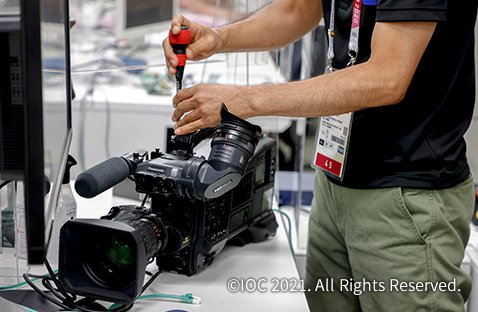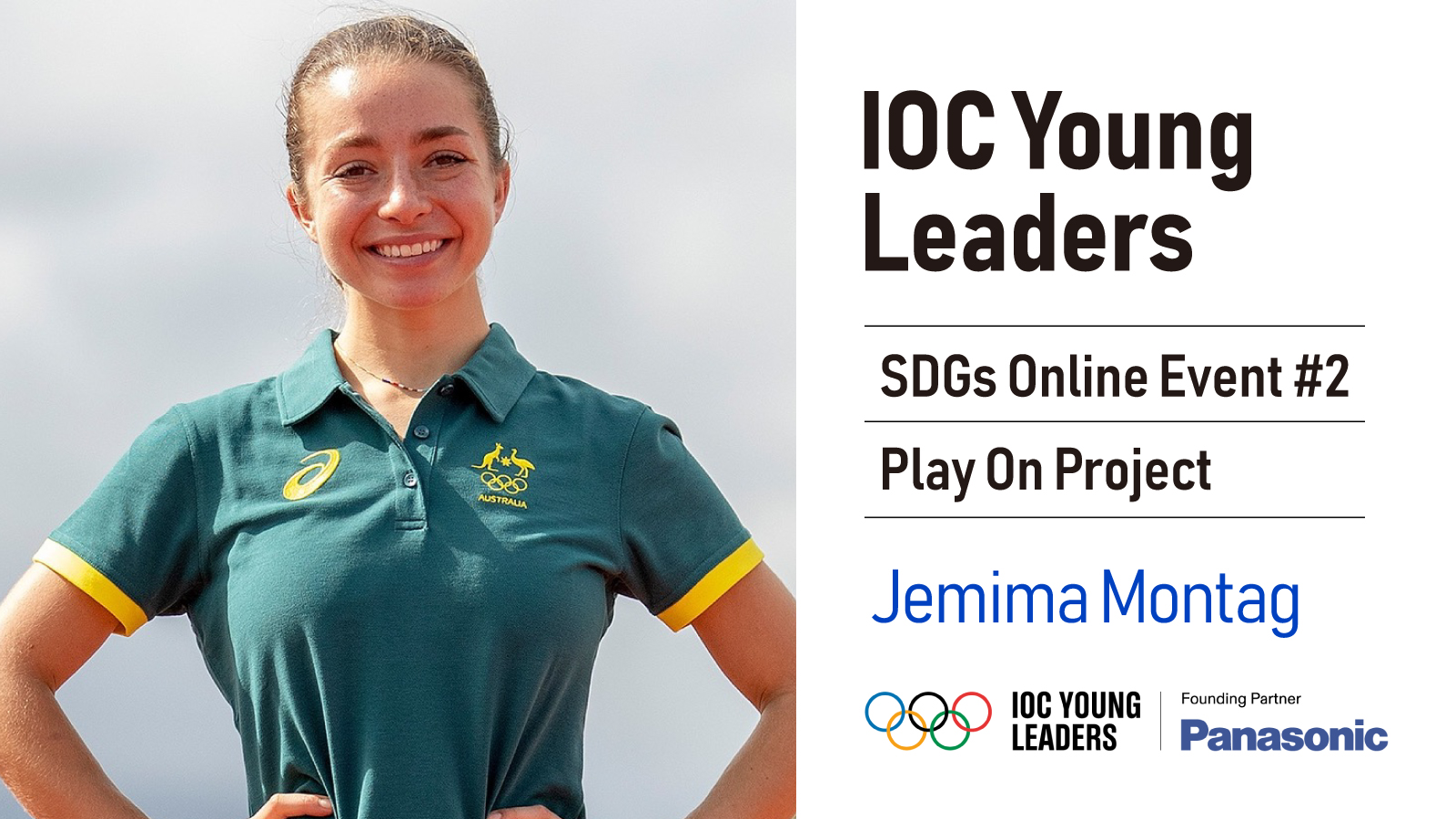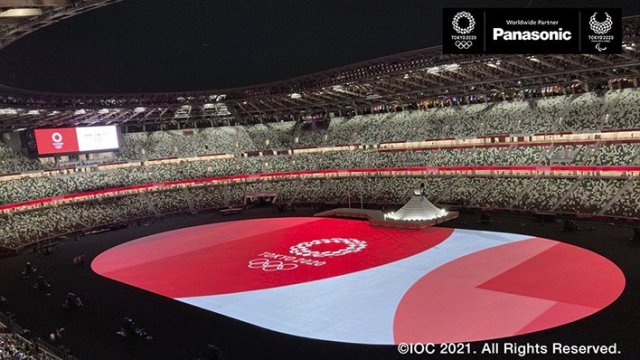
Tokyo 2020 opened after a year's delay and promised to be an event like no other as athletes came together from around the world to once again display the spirit of sport and push against boundaries to achieve the impossible. Despite facing unique challenges, Panasonic remained committed to sharing the passion of sports, of the athletes and the Olympic Games, using the latest AV technologies to create inclusive and immersive experiences for supporters everywhere.
Let's go behind the scenes to see how Panasonic delivered an unforgettable Opening Ceremony with a spectacular light show and projection mapping, and discover the innovations used to deliver a top quality broadcast for at-home audiences this summer.
Breathtaking Light and Color: Augmenting Opening Ceremony with Projection Mapping
During the Opening Ceremony of the Olympic Games Tokyo 2020 on July 23, the Olympic Stadium floor was transformed by a parade of dancers and performers amid an immersive, spatial light show. Through Panasonic's AV technology, the innovative art of projection mapping sees digital effects cast onto surfaces and objects to enhance them with surreal colors, patterns and images. Building off Rio 2016 and PyeongChang 2018, Panasonic took projection mapping to the next level in Japan.
This groundbreaking performance was achieved through the power of Panasonic's 50,000 lm RQ50K projectors, used for the first time in an Olympic ceremony--the ultimate showcase on the world's largest stage.
The RQ50K projectors boast 4K resolution and a brightness roughly two times greater than those used in PyeongChang 2018, creating deep, radiant, and crystal-clear images. Able to cover a massive area, a single RQ50K projector can achieve the same effect as multiple units from previous generations, reducing time and labor during set up.
Another notable feature is the vivid production of red hues, which most conventional projectors find difficult to render with sufficient intensity. To achieve this, Panasonic built a new monochromatic laser that yields a stark red of the same intensity of other colors. Coincidentally, "Japan red" was one of the most notable colors featured at the Opening Ceremony, making the time and effort spent on this upgrade undoubtably worthwhile.
The projector's compact size makes it the smallest 50,000 lm projector in the world. This feat of engineering was born of necessity--the Olympic Stadium's projection tower could not accommodate larger projectors. Reluctant to compromise on function, the Panasonic engineers removed the large support poles of the previous model in favor of a sleek yet sturdy design offering ample room for individual components. Over half of the nearly 4,000 inner parts were also redesigned to retain function with minimal change in size.
One additional issue arose from risk of exposure to inclement weather. While the PyeongChang Olympic Stadium was fitted with specially designed booths to keep equipment safe against rain and snow, the breezy Tokyo Olympic Stadium design ruled out the use of such booths. Finding a different way to securely waterproof the projector against the rain, during the typhoon-prone Japanese summer, was of utmost importance. Unlike the complex reengineering solutions described above, here the Panasonic team went back to basics and wrapped each projector in a plastic film by hand. Thankfully, the Opening Ceremony was held in mostly pleasant weather, allowing Panasonic to put this worry aside and concentrate on the show itself.
Panasonic Technology Helps Take Olympic Broadcasting to Next Level
Since Barcelona 1992, Panasonic has switched from analog to digital, from Standard to High Definition, and from tape to memory cards, and in 2012 it even experimented with 3D broadcasts. This year, Panasonic moved forward in two important ways. First, baseband serial digital interface (SDI) was upgraded to Internet Protocol (IP). Transmitting much greater bandwidth more efficiently also creates space for better audio quality--think clearer sounds that make you feel like you're in the arena--and better video footage. Second, the use of 4K and 8K yields much clearer and more realistic images than HD. The official real-time feed is in HD and 4K, marking an Olympic first, with a special 8K feed available for national broadcasters.
This simple description masks the largest undertaking in broadcasting of any Olympic Games yet: 339 events in 42 different venues being recorded, and footage being processed by a staff of over 5,000 in the International Broadcast Centre building (IBC), set up for the Olympic Games in Tokyo's Bay Area. Overall, 163 broadcasting signals are involved, including, for the first time, 45 in Ultra High-Definition. Adding to this, the Paralympics, with its 540 events, is an even bigger undertaking. While the Olympic Broadcasting Services (OBS) hold overall broadcasting responsibility, Panasonic is playing an important role in constructing and operating the extensive infrastructure.
The IBC typically hosts 15,000-20,000 machines in dozens of rack rooms that process footage for 50-100 national networks, all with distinct broadcasts that can cater to the interests of their domestic audiences. These rooms must be air-conditioned to prevent overheating--an energy-intensive undertaking. To lighten this energy load, Panasonic improved both its software and hardware and introduced a "centralized technical area" that integrates much of the processing, cutting down on duplication and further reducing energy consumption.
Planning and management fell to a team of eight in Panasonic's Broadcast Systems Division. "What would have been a daunting task in normal times was made far more difficult by the pandemic," recounts the team leader. Their responsibilities required working on-site and involved much traveling, and tight deadlines meant that a single infection had the potential to derail everything. Strict anti-infection measures, weekly testing, and a robust system of backups have gotten the team this far without incident.
Of course, the role of the Panasonic team is to operate quietly in the background. If all of Panasonic's innovations, the team's effort and the 15,000 machines whirring in the IBC don't draw any attention throughout the Olympic Games, then that will be the sign of a project well executed.
Panasonic hopes that the technological advances made for the Olympic and Paralympic Games, including those brought about by the pandemic, will continue in the new digital era to create even more spectacular and inclusive events in the future and enable the next generation to revel in the passion and excitement of the Olympic and Paralympic movement.
# # #
Disclaimer:
We would like to note that Panasonic Newsroom is not a place to address personal Customer Service issues. Even though this is not the forum, Panasonic is always eager to resolve your concerns. Our local customer services contacts can be found at Global Support or you can see our list of Social Media Accounts to find the right channel for your queries and concerns.

